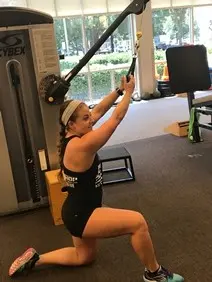Swimming for the high school and collegiate athlete is a year-round commitment that demands hours in the pool each week. Their regimen in the water is constantly changing as they prep for competition. The amount of work the swimming athlete puts in outside of the pool can be just as important as the work that athlete does in the water. The research shows that anywhere from 50-80% of swimmers experience shoulder injury at some point in their swimming career so exercises to maintain mobility, strength, and power for the shoulder and core body muscles are very important. Below are five exercises that target mobility of the shoulder and upper back, strength of the rotator cuff and surrounding core muscles.
Foam Roll T-Spine: The main objective of foam rolling is to relax the spine over the roller so we get some mobility in the vertebral joints of the thoracic spine. The key is to relax your spine over the roller in several different segments along the spine to improve mobility and ultimately improve overhead movements.


Foam Roll Pec Stretch: Stabilize spine with foam roll. Bring bilateral upper extremities up into a goal post and let gravity pull your arms down. Hold for 30 seconds.


Foam Roll Diagonals: Start with arms straight up at shoulder level and pull band apart with (L) arm going up towards ear and (R) arm going towards hip. Hold for a second. Come back to shoulder height. Pull band apart with (R) arm going up towards ear and (L) arm going towards hip. Hold for a second. Return to shoulder height.



Chops and Lifts: While keeping core tight, hold onto the cable with both hands. Bring the cable down from the shoulder to the opposite hip. Shoulders should remain square without rotation.


Cable External Rotation: Start with your elbow by your side at 90 degrees. Keep a towel between your elbow and side while performing this exercise. Your hand should be at your stomach, with your core tight. Pull cable in opposite direction until end of range of motion, and then return to starting position.

Matthew Erbe DPT, OCS is a board-certified orthopedic specialist, a physical therapist with OrthoCarolina Randolph Sports and a rehab consultant for Queens University of Charlotte Athletics.
Back




Leave a Comment